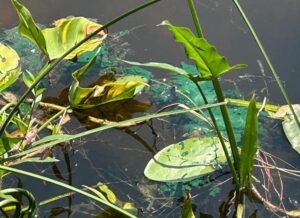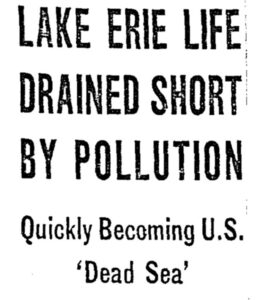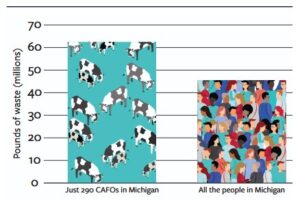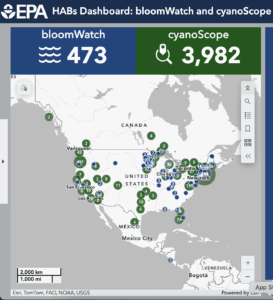July 18, 2025
Toxic Algae in the Great Lakes: Reducing Risk to Find Relief from Summer Heat
In Part 2 of ELPC’s beach blog series, we examine harmful algal outbreaks. Here’s how to help keep people and pets safe from toxic green slime.
By Nancy Stoner, Senior Attorney

Blue Green Algae in a Michigan lake
This summer has been a scorcher already, with record-setting heat waves sending Midwesterners to the lake for relief. But beachgoers beware! Harmful algal outbreaks can fuel cyanotoxic bacterial contamination and close Great Lakes beaches, so make sure to check before diving in. Here’s what you should know about harmful algal outbreaks, how ELPC is fighting to prevent them, and how you can keep your family safe this summer.
Harmful Algal Outbreaks in the Great Lakes
Harmful algal outbreaks (also known as harmful algal blooms or HABs) result from having too many nutrients in the water, often from human or animal waste or farm fertilizers in the water. Excessive nutrients in the waste, especially dissolved reactive phosphorus or bioavailable phosphorus, feed algal growth into enormous outbreaks, some of which can produce dangerous toxins. Harmful algal outbreaks are on the rise in several areas of the Great Lakes, including Western Lake Erie, Saginaw Bay, and Green Bay, due to warmer waters from climate change, more waste in the water from larger storm events, and large, concentrated animal feedlots in the watersheds that feed the Great Lakes.

Satellite view of Lake Erie’s toxic algae blooms
The toxins in harmful algal outbreaks pose risks to your health and to the health of your pets if they are inhaled or ingested. You can be exposed by touching or swallowing the water, eating contaminated fish, or even inhaling the toxins that can be associated with algal outbreaks. They can even shut down drinking water systems, as happened in Toledo in the summer of 2014. In fact, this year, microcystin, a dangerous toxin associated with some harmful algal outbreaks, was detected in Lake Erie many weeks earlier in the season than usual.
Harmful algal outbreaks also cause serious and negative environmental impacts, including aquatic “dead zones,” which are when there is so little oxygen in the water that aquatic life cannot survive. The dead zone in Lake Erie is estimated to be as big as 10,000 square kilometers – the size of Delaware and Rhode Island combined. According to experts, the problem is likely to get worse. In 2023, the U.S. EPA declared that “the prevalence, severity, and frequency of [harmful algal outbreak] occurrences in recreational waters . . . will increase as excess nutrients flow into these waters, temperatures rise, and extreme weather events increase with a changing climate.”
The NOAA GLERL time-lapse video from 2011 provides a striking visual of how the Lake Erie harmful algal bloom (HAB) developed and expanded over several months. This year was particularly significant because it marked one of the most severe HAB events on record, with a bloom severity index of 10, the highest measured at the time. The video captures the progression from early bloom formation in midsummer to widespread coverage by fall, clearly illustrating how visible and extensive the outbreak was. This event is further highlighted in a satellite image from October 2011, provided by NASA’s Moderate Resolution Imaging Spectroradiometer (MODIS), showing the bloom’s dense surface coverage across western Lake Erie.
What Can We Do About It?

Chicago Tribune headline, 1967
This problem is solvable. In fact, back before the 1970s and 1980s, there was a similar wave of harmful algal outbreaks in Lake Erie. But they largely disappeared thanks to the Clean Water Act. In the early years after its passage in 1972, the Clean Water Act delivered dramatic successes in cleaning up Lake Erie. The lake’s infamous green scum rapidly diminished in those early decades thanks to the Act’s permitting program, which limited phosphorus pollution from sewage treatment plants. Phosphorus in laundry detergent was also widely banned, leading to significant reductions in harmful algal outbreaks. But starting in the late 1990s, the green scum started to reappear in Lake Erie and in other waters across the country due to a pollution source that has proven more difficult to control: agriculture.
Pollution from agriculture is the leading cause of harmful algal outbreaks in many parts of the Great Lakes, especially waste from industrial-scale livestock production facilities known as Concentrated Animal Feeding Operations (CAFOs). As of 2012, large CAFOs in the United States produced more than 20 times the volume of fecal wet mass produced by all of the country’s humans. But human waste is treated to remove contaminants, whereas livestock is spread as raw untreated sewage on land across the country, polluting surface and groundwater.

Michigan’s 290 permitted concentrated animal feeding operations produce 17 million pounds more waste per day than the state’s population of 10 million people. Click to learn more.
Unfortunately, CAFOs are not treated like the industrial polluters they are. CAFOs should be held to the same ‘polluter pays’ principle that any wastewater treatment plant, steel mill, or oil company must abide by to reduce the pollutants they release into the environment. ELPC is working throughout the Great Lakes to ensure that federal and state investments in infrastructure are moving forward and that CAFOs are held to higher standards and not allowed to pollute beach waters with excess animal waste where it can make you and your family sick. We provide public comment, scientific data, and written testimony in support of stronger water standards and hold polluters accountable when they don’t follow the rules.
How to Stay Safe This Summer
Fortunately, there are a number of resources available to check for water quality at your local beach or favorite vacation spot. The EPA’s BloomWatch and CyanoScope dashboard is the most comprehensive nationwide hub, but there are also state-level resources that can help you avoid toxins and stay safe. Check out Indiana’s Blue-green Algae Dashboard, Minnesota’s Water Recreation Advisories, and Michigan’s Harmful Algal Bloom Report Map. Contact your elected officials and tell them to protect clean water, and support ELPC in its work to fight water pollution.
To learn more about avoiding other pollution risks at the beach, read Part 1 of ELPC’s Beach Blog Series about E. Coli here:



